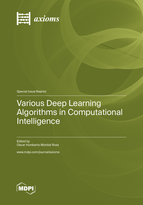Various Deep Learning Algorithms in Computational Intelligence
A special issue of Axioms (ISSN 2075-1680). This special issue belongs to the section "Mathematical Analysis".
Deadline for manuscript submissions: closed (31 January 2023) | Viewed by 38093
Special Issue Editor
Interests: intelligent systems; quantum computing; quantum intelligent systems; evolutionary computation; fuzzy systems; neural networks; deep learning; computational intelligence
Special Issues, Collections and Topics in MDPI journals
Special Issue Information
Dear Colleagues,
Deep learning (Dl) is an essential topic of increasing interest in science, industry, and academia. Unlike traditional and machine learning methods, Dl methods can process large volumes of unstructured data. It is rapidly becoming a tool for modeling and solving complex and difficult problems in different fields of science and technology. For example, in medicine in breast cancer, COVID-19 detection and diabetes detection and prediction; in autonomous vehicles in various tasks such as perception, mapping and localization; in astronomy, for classifying and detecting stars and galaxies; in the design of future wireless networks, and others. Although Dl has been successfully applied in many fields and there are some theoretical developments, there are still many challenging problems in theory and applications that need to be solved for improving these techniques. For instance, it is important to find new methods for training the massive number of parameters required by Dl architectures, solve over-fitting and transfer learning problems, and others. This Special Issue aims to contribute to the state-of-the-art progress on Dl with theoretical, practical, and creative insights that provide vanguard solutions to challenging problems or can demonstrate competitive performance.
Prof. Dr. Oscar Humberto Ross
Guest Editor
Manuscript Submission Information
Manuscripts should be submitted online at www.mdpi.com by registering and logging in to this website. Once you are registered, click here to go to the submission form. Manuscripts can be submitted until the deadline. All submissions that pass pre-check are peer-reviewed. Accepted papers will be published continuously in the journal (as soon as accepted) and will be listed together on the special issue website. Research articles, review articles as well as short communications are invited. For planned papers, a title and short abstract (about 100 words) can be sent to the Editorial Office for announcement on this website.
Submitted manuscripts should not have been published previously, nor be under consideration for publication elsewhere (except conference proceedings papers). All manuscripts are thoroughly refereed through a single-blind peer-review process. A guide for authors and other relevant information for submission of manuscripts is available on the Instructions for Authors page. Axioms is an international peer-reviewed open access monthly journal published by MDPI.
Please visit the Instructions for Authors page before submitting a manuscript. The Article Processing Charge (APC) for publication in this open access journal is 2400 CHF (Swiss Francs). Submitted papers should be well formatted and use good English. Authors may use MDPI's English editing service prior to publication or during author revisions.
Keywords
- Autonomous vehicles and robotics
- Applications in medicine, healthcare, and clinical decision support
- Future wireless networks
- Big data in astronomy
- Complex systems modeling
- Deep learning in Blockchain and finance
- Transfer learning and other learning methods
- Novel deep learning architectures
- Novel optimization methods for deep learning
- Deep learning for EEG motor imagery
- Deep learning for architecture design
- Computer vision
- Natural language processing
- Human activity recognition
- Any novel theoretical development on deep learning
- Any novel competitive application with potential industrial impact





